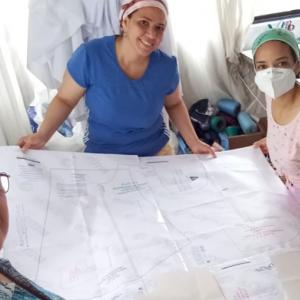Priorities for funders and development organizations
1. Help governments to make better use of collective intelligence
People are collecting, creating and sharing data on an unprecedented scale – but governments and some development organizations have been slow to make the most of new methods. Most of the projects in this report are being developed and implemented by social movements, civil society organizations and researchers. Many governments are unfamiliar with the many new sources of data now available – from satellite data to mobile data and citizen-generated data. The opportunities are immense, but greatly underutilized. A recent systematic review of the contribution of citizen science to the SDGs, for example, found that citizen science methods have the potential to contribute to the monitoring of all 17 SDGs (at least one indicator per goal). But it also found that at present citizen science is only being used by governments to monitor five indicators.
The biggest leverage will come through helping governments make the most of the new tools and collective intelligence methods that are available and already being harnessed.
2. Open data and open software have enabled widespread experimentation – but now need to become the default for sustainable development
Open source software and data such as OpenStreetMap, Ushahidi and Consul have greatly accelerated distributed experimentation with collective intelligence methods by a wide range of organizations, from city municipalities to community-based organizations. The free availability of NASA’s Landsat and, likewise, the European Space Agency’s Sentinel satellite data has resulted in an explosion of collective intelligence projects in the last few years – including the Global Forest Watch platform.
Collective intelligence thrives best when underpinned by strong infrastructures. The most important of these is the internet itself. But other infrastructures built on top of it are also becoming increasingly vital. Open source collective intelligence platforms such as OpenStreetMap and Consul receive relatively little core funding but are used by many projects. Often these depend both on open standards and open access technology, as well as the work of many volunteers – a very valuable set of public goods that are rarely well-supported by traditional global, national or philanthropic funders.
Open data standards and open access technology are critical infrastructures for collective intelligence, enabling faster experimentation and adoption by disparate communities, scaling across geographies and more rapid learning about what works. However, these are still not the default for global development, and many platforms are still being created that are not open in these ways or reinvent the wheel, rather than improving and building on what’s already available.
3. Trust and values matter in collective intelligence systems – and need to be cultivated
All collective intelligence projects depend on trust and goodwill. When they work well they also contribute to trust. As they start to underpin even more of the civic infrastructure it will also become more vital that considerations of ethics and personal privacy are taken seriously, and seen to be taken seriously. The recently abandoned Google Sidewalk Labs project in Toronto came under fierce criticism for taking a top-down ‘technology push’ approach that prioritized technology and data over people and purpose. Governments like Taiwan, however, are demonstrating an alternative: creating collective intelligence systems that enable citizens to collaborate in solving problems, allowing them to access and use data. Barcelona’s sensor network also gives citizens control over how their data is used. These new models of distributed governance and responsibility are paving the way towards a social contract that uses collective intelligence to empower all stakeholders to take action, from governments and organizations to individuals. As development organizations and governments seek to make use of collective intelligence it’s important that the values and principles that underpin these new approaches and technologies are paid sufficient attention, and that benefits outweigh risks. A commitment to data empowerment, not data extraction, must remain central.
4. Novel combinations of AI and collective intelligence could help deliver insight on the SDGs
The world has seen extraordinary investment in AI over the last few years, both from government and business. The big investments in ‘AI for good’ are welcome, after many decades when far more was spent on military and commercial applications than in relation to global goals. Some research suggests that AI could act as an enabler on 134 targets (79 per cent) across all SDGs.
But in many fields the full value of AI depends on linking it to human collective intelligence – and AI funders have been slow to appreciate this. Most current uses of AI-enabled collective intelligence for the SDGs focus on optimizing for speed or making sense of vast quantities of citizen-generated data. Yet, even these ‘lowest hanging fruits’ are not always used when they could be. There is significant scope for experimentation in more creative uses of AI that help to enhance the reach, creativity and impact of collective intelligence.
Investing in a dedicated program of innovation, perhaps through regional or sectoral testbeds (for example focused on one use case, SDG or region) would allow for experimentation in real-world settings. A particular priority is to build up more centers of expertise, particularly in sub-Saharan Africa, to counter the concentration and overdependence on mainly US firms for AI and data proficiency.
5. Build the field, and develop the methods further for the SDGs
The field remains relatively young and, as has happened with other fields (such as the use of big data or new performance management tools), there is a need to develop the methods and adapt them to multiple uses. This can be done through:
Growing evidence:
Tools such as crowdmapping and citizen science have been used for SDG-related projects for over a decade. Their uptake could be further aided by creating a stronger evidence base around impact, as well as supporting collaborative experimentation with these tools in a greater number of communities. This could be achieved by bolstering civil society organizations, who are already at the forefront of trying many of these methods, and leveraging universities to support in generating more systematic learning about what works best and why.
Skills:
Training in collective intelligence methods needs to become part of the default for anyone involved in development, including government officials and NGOs.
Connections:
The field will also develop faster if innovators themselves become more of a collective intelligence, sharing observations, ideas, experiments, findings and results. At present, this kind of orchestration is very ad hoc. Whereas the leading edges of science and medicine are supported by strong and well-funded institutions to maximize the flow of information and knowledge, there is very limited comparable support for innovators working around the SDGs, which means that a lot of work is less effective than it could be.












